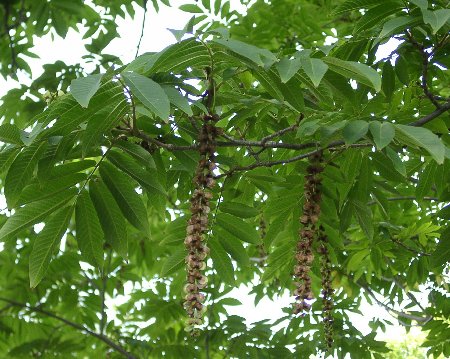- Wingnut (plant)
Taxobox
name = Wingnut

image_width = 240px
image_caption = Japanese Wingnut ("Pterocarya rhoifolia")
regnum =Plant ae
divisio = Magnoliophyta
classis = Magnoliopsida
ordo =Fagales
familia =Juglandaceae
genus = "Pterocarya"
genus_authority = Nutt. ex Moq.
subdivision_ranks = Species
subdivision = See textThe wingnuts are
plant s in the genus "Pterocarya" (fromAncient Greek "pteron", "wing" + "karyon", "nut ") in the walnut familyJuglandaceae , native toAsia .Description
They are
deciduous tree s, 10-40m tall, withpinnate leaves 20-45cm long, with 11-25 leaflets; the shoots have chamberedpith , a character shared with thewalnut s ("Juglans") but not the hickories ("Carya") in the same family.The
flower s are monoecious, incatkin s. The seed catkins when mature (about 6 months after pollination) are pendulous, 15-45 cm long, with 20-80 seeds strung along them.The
seed s are a small nut 5-10 mm across, with two wings, one each side. In some of the species, the wings are short (5-10 mm) and broad (5-10 mm), in others longer (10-25 mm) and narrower (2-5 mm).pecies
There are six species of wingnut.
*"Pterocarya fraxinifolia " - Caucasian Wingnut.Caucasus andElburz mountains in southwestAsia .
*"Pterocarya hupehensis " - Hubei Wingnut. CentralChina .
*"Pterocarya macroptera " - Large-winged Wingnut. West and southwestChina .
*"Pterocarya rhoifolia " - Japanese Wingnut.Japan , easternChina (Shandong ).
*"Pterocarya stenoptera " - Chinese Wingnut.China , widespread.
*"Pterocarya tonkinensis " - Tonkin Wingnut. SouthernmostChina (Yunnan ),Indo-China .Another species from China, the Wheel Wingnut with similar foliage but an unusual circular wing right round the nut (instead of two wings at the sides), previously listed as "Pterocarya paliurus", has now been transferred to a new genus, as "
Cyclocarya paliurus ".Uses
Wingnuts are very attractive, large and fast-growing trees, occasionally planted in
park s and largegarden s. The commonest in general cultivation outside of Asia is "P. fraxinifolia", but the most attractive is probably "P. rhoifolia". The hybrid "P. x rehderiana", a cross between "P. fraxinifolia" and "P. stenoptera", is even faster-growing and has occasionally been planted fortimber production. Thewood is of good quality, similar towalnut , though not quite so dense and strong.External links
* [http://www.efloras.org/florataxon.aspx?flora_id=2&taxon_id=127445 Flora of China - "Pterocarya"]
* [http://www.efloras.org/florataxon.aspx?flora_id=2&taxon_id=108834 Flora of China - "Cyclocarya"]
Wikimedia Foundation. 2010.
